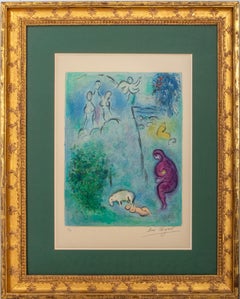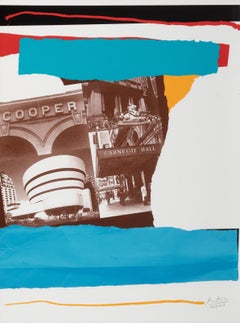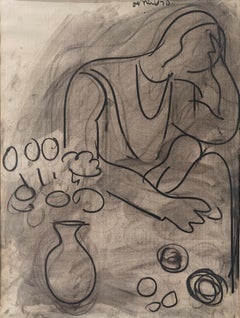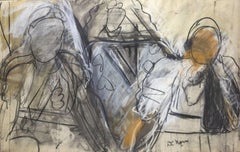Robert de Niro, Sr. Art
American, 1922-1993
Robert De Niro Sr. was born in Syracuse, New York, to an Irish-American mother, Helen M. (née O'Reilly; 1899–1999). Helen's mother was Mary E. Burns (born to John and Mary Burns) and her father was Dennis Francis O'Reilly, born to Dundrum's Ellen Hall, the second wife of Edward O'Reilly.[4] There was previous confusion about Dennis' maternity, his mother previously thought to be Edward's second wife Margaret.[5] Robert was the eldest of three children; he and siblings John and Joan were raised in Syracuse. De Niro studied at Black Mountain College under Josef Albers from 1939 to 1940. While Albers' highly analytical approach to painting did not appeal to De Niro's more instinctive style, the experience and international perspective of the Bauhaus master nonetheless left a lasting impression. De Niro studied with Hans Hofmann at his Provincetown, Massachusetts, summer school. Hofmann's teaching on Abstract Expressionism and Cubist formalism had a strong influence on De Niro's development as a mature artist.
At Hofmann's summer school, he met fellow student Virginia Admiral, whom he married in 1942. The couple moved into a large, airy loft in New York's Greenwich Village, where they were able to paint. After studying with Hans Hofmann in New York and Provincetown and Josef Albers at Black Mountain College, North Carolina in the late 1930s and early 1940s, De Niro worked for five years at Hilla Rebay's legendary Museum of Non-Objective Art. In 1945, he was included in a group show at Peggy Guggenheim's Art of This Century in New York, which was a leading gallery for the art of both established European modernists and members of the emerging Abstract Expressionist group like Jackson Pollock, Mark Rothko, Robert Motherwell, and Clyfford Still. De Niro had his first solo exhibition at Guggenheim's gallery in April and May of the following year. At that point, he was primarily working in an abstract manner, often with figural references. Much of his work from this period was lost in a studio fire in 1949.
Critics praised DeNiro's compositions filled with improvised areas of vibrant color that gave way to loosely painted still lifes and curvaceous nudes. By the mid-1950s, De Niro was regularly included in important group exhibitions such as the Whitney Annual, the Stable Annual, and the Jewish Museum. He was awarded a Longview Foundation award in 1958.
From 1961 to 1964, De Niro traveled to France to paint in Paris and in the surrounding countryside. Collector Joseph Hirshhorn purchased a number of the artist's paintings and works on paper during this period through De Niro's gallerist, Virginia Zabriskie, which are now in the permanent collection of the Hirshhorn Museum and Sculpture Garden in Washington, DC. In 1968, he was awarded a Guggenheim Fellowship.to
1
1
Overall Width
to
Overall Height
to
1
1
1
1
1
1
1
1
1
1
10,027
2,754
1,379
1,375
1
1
Artist: Robert de Niro, Sr.
Woman With Orange Hat & Suitcase
By Robert de Niro, Sr.
Located in Chattahoochee Hills, GA
Extremely rare lithograph on mulberry paper. Floated on linen with 23K gilded hand made 1978 H Benevy frame. Purchased from the artist 1980. A signed artist proof from an edition...
Category
1970s Abstract Expressionist Robert de Niro, Sr. Art
Materials
Lithograph
$6,800 Sale Price
20% Off
Related Items
Marc Chagall (1887-1985) "Daphnis Discovers Chloe"
By Marc Chagall
Located in Los Angeles, CA
Marc Chagall (1887-1985)
"Daphnis Discovers Chloe"
from ...
Category
1960s Abstract Expressionist Robert de Niro, Sr. Art
Materials
Lithograph
$36,000
H 32 in W 25.5 in D 1.5 in
Cultural Institutions, Abstract Expressionist Lithograph by Robert Motherwell
By Robert Motherwell
Located in Long Island City, NY
This print by Robert Motherwell is part of an 8-piece portfolio published by The New York Graphic Society in 1983 and includes works from Red Grooms, Robert Indiana, Alex Katz, R.B. ...
Category
1980s Abstract Expressionist Robert de Niro, Sr. Art
Materials
Lithograph
Robert MotherwellCultural Institutions, Abstract Expressionist Lithograph by Robert Motherwell, 1983
$2,800 Sale Price
20% Off
H 30 in W 22.5 in
abstract composition
By Marie Raymond
Located in Belgrade, MT
This color lithograph is part of my private collection since the 1970's. Marie Raymond was a pioneer post WWII painter of her generation. She was a lyrical abstractionist of her time...
Category
Mid-20th Century Abstract Expressionist Robert de Niro, Sr. Art
Materials
Color, Lithograph
Original Lithograph PENCIL SIGNED Ed. 30/150 Affiche avant la lettre LAS MUJERAS
By Rufino Tamayo
Located in New York, NY
Here we have an Original Pencil Signed and Numbered Lithograph by Rufino Tamayo, famous Mexican American Artist…. known for abstract Figurative Expressionist images
There was only a...
Category
1960s Abstract Expressionist Robert de Niro, Sr. Art
Materials
Lithograph
$3,400
H 33 in W 25 in D 1 in
Bacon, Le Boeuf, 1986
By Francis Bacon
Located in Fairfield, CT
Artist: After Francis Bacon (1909-1992)
Title: Le Boeuf, exhibition poster
Year: 1986
Medium: Offset Lithograph on premium paper
Size: 30.75 x 18 inches
Condition: Excellent
Notes: Published by Foundation Maeght
FRANCIS BACON (1909-1992) Francis Bacon has a distinctive style as a figure painter. In his mature style, developed in the 1950s, the paintings include images of either friends or lovers, or images of people found in movie stills...
Category
1980s Abstract Expressionist Robert de Niro, Sr. Art
Materials
Lithograph, Offset
Bacon, Portrait Isabel Rawsthorne, 2003 (after)
By Francis Bacon
Located in Fairfield, CT
Artist: Francis Bacon (1909-1992)
Title: Portrait Isabel Rawsthorne
Year: 2003
Medium: Offset Lithograph on premium paper
Size: 39.25 x 27.5 inches
Condition: Excellent
Notes: Publis...
Category
Early 2000s Abstract Expressionist Robert de Niro, Sr. Art
Materials
Lithograph, Offset
Cup 2 Picasso (Sparks 113; Field 168; ULAE 123), Jasper Johns
By Jasper Johns
Located in Fairfield, CT
Artist: Jasper Johns (1930)
Title: Cup 2 Picasso (Sparks 113; Field 168; ULAE 123)
Year: 1973
Medium: Color lithograph on wove paper
Edition: 1,500
Size: 14 x 10.5 inches
Inscription: Signed & dated with the artist's plate-signed signature.
Condition: Excellent
Notes: This image, as well as a companion print Cups 4 Picasso, is based on Marcel Duchamp’s 1958 collage Self-Portrait in Profile. Printed by Bill Goldston and James V...
Category
1970s Abstract Expressionist Robert de Niro, Sr. Art
Materials
Lithograph
$556 Sale Price
20% Off
H 14 in W 10.5 in
Serigraphie Fernand Leger
By Fernand Léger
Located in Belgrade, MT
This print is part of my private collection. They were published in a numbered unsigned edition of 1000, and a signed edition of 200, printed by Serifraphie Fernand Leger, Paris and ...
Category
Mid-20th Century Abstract Expressionist Robert de Niro, Sr. Art
Materials
Lithograph
Nature Morte Harvest scene
By Maurice Savin
Located in Belgrade, MT
This lithograph is part of my private collection. It is original and pencil signed an numbered by the artist.
It is one of a kind in black and white.
Category
Mid-20th Century Abstract Expressionist Robert de Niro, Sr. Art
Materials
Engraving, Lithograph
Fleure polychromes, original lithograph
Located in Belgrade, MT
Catherine Ann Lurcat ( 1932-1994) was a French artist and painter born in Boulogne-Billancourt in the inner southwestern suburbs of Paris, and is the daughter of the architect Andre'...
Category
Mid-20th Century Abstract Expressionist Robert de Niro, Sr. Art
Materials
Lithograph
Johns, Two Cup Picasso (ULAE 123) (after)
By Jasper Johns
Located in Fairfield, CT
Artist: Jasper Johns (1930)
Title: Two Cup Picasso
Year: 1981
Medium: Lithograph and silkscreen on premium paper
Size: 14 x 10.5 inches
Inscription: Signed & dated with the artist's ...
Category
1970s Abstract Expressionist Robert de Niro, Sr. Art
Materials
Lithograph
Mecklenburg Autumn
By Romare Bearden
Located in Washington, DC
Title: Mecklenburg Autumn
Medium: Lithograph in colors
Year: 1979
Edition: AP (artist's proof, aside from the edition of 175)
Signature: Stamped signature
Image Size: 22 1/4" x 17 1/...
Category
1970s Abstract Expressionist Robert de Niro, Sr. Art
Materials
Lithograph
Previously Available Items
"Seated Figure and Flowers in a Vase" Robert de Niro Sr., Modernist Figure
By Robert de Niro, Sr.
Located in New York, NY
Robert de Niro Sr.
Seated Figure and Flowers in a Vase, 1970
Signed and dated upper center
Charcoal on paper
Sight 25 1/2 x 19 inches
Provenance
The artist
Private Collection, Prin...
Category
1970s American Modern Robert de Niro, Sr. Art
Materials
Paper, Charcoal
Two Figures, c.1960
By Robert de Niro, Sr.
Located in Wilton Manors, FL
Robert De Niro Sr. (1922-1993). Two Figures, c. 1955. Ink, paint, charcoal, pastel and conte crayon on paper. Sheet measures 26 x 40 inches; 28 x 42 ...
Category
1950s Abstract Expressionist Robert de Niro, Sr. Art
Materials
Mixed Media, Rag Paper
Modernist Street View by Robert de Niro Sr.
By Robert de Niro, Sr.
Located in Buffalo, NY
Modernist painting of a street view by Robert de Niro Sr (1922-1993). Oil on canvas, circa 1967. Signed lower right, "De Niro '67". Disp...
Category
1960s Modern Robert de Niro, Sr. Art
Materials
Canvas, Oil
Robert De Niro, Sr. art for sale on 1stDibs.
Find a wide variety of authentic Robert de Niro, Sr. art available for sale on 1stDibs. If you’re browsing the collection of art to introduce a pop of color in a neutral corner of your living room or bedroom, you can find work that includes elements of orange and other colors. You can also browse by medium to find art by Robert de Niro, Sr. in lithograph and more. Much of the original work by this artist or collective was created during the 1970s and is mostly associated with the abstract style. Not every interior allows for large Robert de Niro, Sr. art, so small editions measuring 19 inches across are available. Customers who are interested in this artist might also find the work of James Brooks, Louise Nevelson, and Sam Gilliam. Robert de Niro, Sr. art prices can differ depending upon medium, time period and other attributes. On 1stDibs, the price for these items starts at $8,500 and tops out at $8,500, while the average work can sell for $8,500.



